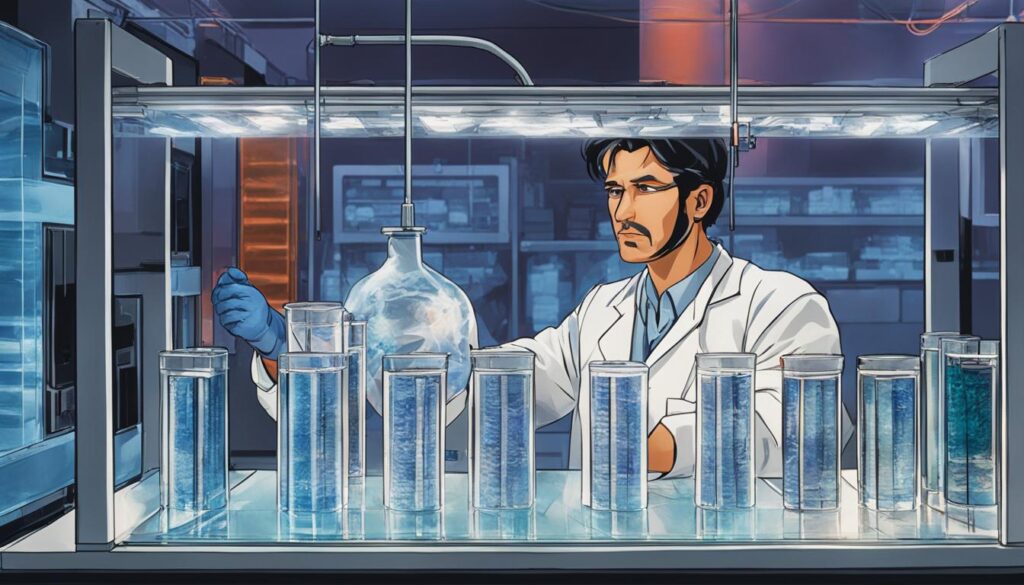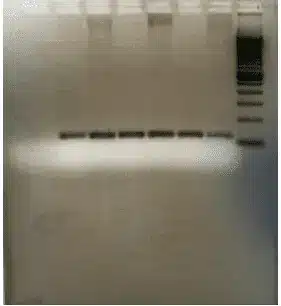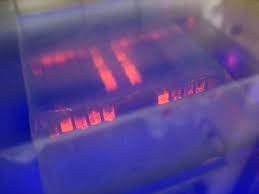Welcome to our comprehensive guide on gel electrophoresis troubleshooting. Gel electrophoresis is a powerful technique used for DNA, RNA, and protein separation, providing valuable insights into genetic and molecular mechanisms. However, like any experimental method, it can present challenges that need to be overcome for reliable results. In this article, we will explore common issues, offer expert tips, and provide solutions to help you navigate the complexities of gel electrophoresis troubleshooting.
Key Takeaways:
- Successful gel electrophoresis is crucial for accurate DNA, RNA, and protein separation.
- Issues such as distorted bands, poor resolution, and smearing can arise during gel electrophoresis.
- Using high-quality equipment and fresh reagents is essential for optimal results.
- Proper sample preparation techniques, buffer optimization, and gel running conditions are vital for successful gel electrophoresis.
- Specific troubleshooting strategies are available for DNA, RNA, and protein separations.
Common Gel Electrophoresis Issues
Gel electrophoresis is a powerful technique for DNA, RNA, and protein separation. However, like any scientific method, it is not without its challenges. In this section, we will explore the most common issues that can arise during gel electrophoresis and provide insights into their potential causes.
1. Distorted Bands
One of the most frustrating issues in gel electrophoresis is the appearance of distorted bands. These bands may be asymmetrical, irregular in shape, or show smearing. Distorted bands can make it difficult to accurately analyze and interpret the results.
The possible causes of distorted bands include:
- Uneven gel concentration
- Inadequate sample loading
- Poor sample preparation
- Overloading the gel
- Excessive heat during gel preparation or running
2. Poor Resolution
Poor resolution is another common issue encountered in gel electrophoresis. It refers to the inability to separate DNA, RNA, or proteins with sufficient clarity and distinction. This can make it challenging to accurately identify and analyze the desired molecules.
The potential causes of poor resolution include:
- Incorrect agarose percentage
- Insufficient run time
- Wrong buffer composition
- Improper staining techniques
- Expired or contaminated reagents
3. Smearing
Smearing is the presence of diffuse, blurry bands on the gel, which can hinder the interpretation of results. It is often associated with issues in sample preparation and can lead to inaccurate analysis and conclusions.
The common causes of smearing include:
- Contaminated samples
- Insufficient DNA, RNA, or protein purification
- Protein degradation
- Uneven sample loading
- Running the gel at incorrect voltage
Understanding and addressing these common gel electrophoresis issues is crucial for obtaining reliable and accurate results. In the following sections, we will explore the solutions to these problems, discuss equipment and reagent considerations, and provide guidance on sample preparation, buffer optimization, and running conditions. By mastering these troubleshooting techniques, you will improve the quality and reliability of your gel electrophoresis experiments.
Equipment and Reagent Considerations
Using high-quality gel electrophoresis equipment and reagents is crucial for achieving accurate and reproducible results in your experiments. Subpar equipment or expired reagents can lead to compromised data and unreliable analysis. In this section, we will highlight the importance of investing in reliable equipment and ensuring the freshness of your reagents for successful gel electrophoresis.
Choosing the Right Gel Electrophoresis Equipment
When selecting gel electrophoresis equipment, consider factors such as gel size, power supply, and safety features. Investing in a high-quality gel electrophoresis unit will ensure consistent performance and minimize the risk of equipment failure. Look for features such as:
- Suitable gel size options to accommodate your sample volumes
- Adjustable power settings for controlling voltage and current
- Built-in safety features like current limiters and overheating protection
By choosing reliable equipment, you can avoid issues such as uneven sample migration, band distortion, and inconsistent separation.
Maintaining and Calibrating your Equipment
Regular maintenance and calibration of your gel electrophoresis equipment are essential for optimal performance and accurate results. Follow the manufacturer’s guidelines for cleaning and maintaining gel trays, electrodes, and power supplies.
To ensure accurate voltage and current delivery, periodically calibrate your power supply using a multimeter and reference solutions. This will help prevent voltage fluctuations and ensure consistent separation during gel electrophoresis.
Optimizing Gel Electrophoresis Reagents
The quality and freshness of your gel electrophoresis reagents can significantly impact the reliability of your results. Expired or substandard reagents can lead to poor band resolution, increased background noise, and compromised gel integrity.
When purchasing reagents, check the expiration dates and ensure they have been stored properly. It’s also a good practice to test new reagents using control samples to verify their effectiveness before using them in important experiments.
Consider using pre-cast gels or gel kits that offer consistent quality and reliable results. These kits often contain pre-measured buffers, stains, and markers, reducing the chances of errors in reagent preparation. However, do check the compatibility of these kits with your specific experimental requirements.
By investing in high-quality gel electrophoresis equipment and ensuring the freshness and reliability of your reagents, you can minimize experimental errors and obtain accurate, reproducible results.
Sample Preparation Techniques
The proper preparation of samples is a critical step in gel electrophoresis troubleshooting. Failure to follow correct sample preparation techniques can lead to various issues that affect the quality of DNA, RNA, or protein separation. In this section, we will discuss common problems related to sample contamination, insufficient loading volume, and improper isolation techniques, along with recommendations for effective sample preparation.
1. Sample Contamination
Contamination of samples can introduce foreign substances that interfere with the electrophoretic migration of DNA, RNA, or proteins. Common sources of contamination include dust particles, nucleases, and other biomolecules present in the laboratory environment. To minimize the risk of sample contamination:
- Use sterile equipment and work in a clean, dedicated workspace.
- Always wear gloves and use proper handling techniques to avoid contact between samples and external contaminants.
- Regularly clean and maintain equipment to prevent the buildup of dust and contaminants.
2. Insufficient Loading Volume
Insufficient loading volume can result in weak or indistinct bands on the gel. This can occur when the amount of DNA, RNA, or protein loaded onto the gel is too low. To ensure sufficient loading volume:
- Accurately measure the concentration of your sample using appropriate methods, such as spectrophotometry.
- Follow recommended loading volume guidelines provided by the manufacturer or established protocols.
- Consider adjusting the concentration of your sample to ensure optimal band intensity without overloading the gel.
3. Improper Isolation Techniques
Improper isolation techniques can yield impure samples that contain contaminants or degraded DNA, RNA, or proteins. This can result in distorted bands or smearing on the gel. To ensure proper isolation:
- Choose the appropriate isolation method based on the type of biomolecule you are working with.
- Follow established protocols or manufacturer instructions carefully to maximize yield and purity.
- Consider using advanced isolation techniques, such as column purification, to improve the quality of your samples.
By paying careful attention to sample preparation techniques, you can avoid many of the common issues that affect gel electrophoresis results. Next, we will discuss buffer and voltage optimization and their impact on the separation process.
| Common Sample Preparation Issues | Potential Causes | Recommendations |
|---|---|---|
| Contamination of samples | Presence of dust particles, nucleases, or other biomolecules | – Use sterile equipment and work in a clean environment. – Wear gloves and follow proper handling techniques. – Regularly clean and maintain equipment. |
| Insufficient loading volume | Low amount of DNA, RNA, or protein loaded onto the gel | – Accurately measure sample concentration. – Follow recommended loading volume guidelines. – Consider adjusting sample concentration if necessary. |
| Improper isolation techniques | Contaminants or degraded biomolecules in the sample | – Choose appropriate isolation method. – Follow established protocols or manufacturer instructions. – Consider using advanced isolation techniques. |
Buffer and Voltage Optimization
In gel electrophoresis troubleshooting, achieving optimal separation quality relies heavily on careful buffer selection and voltage optimization. The choice of gel electrophoresis buffer and voltage settings can significantly impact the resolution, speed, and accuracy of your experiment.
When it comes to gel electrophoresis buffer, it is crucial to consider factors such as ionic strength, pH, and the presence of any specific additives. Different buffer compositions can alter the migration speed of DNA, RNA, or proteins through the gel matrix, affecting band sharpness and overall resolution. It is recommended to use commercially available buffers that have been optimized for specific applications.
To optimize your gel electrophoresis buffer, try experimenting with different formulations and concentrations to find the ideal balance for your sample. Keep in mind the characteristics of your target molecules and adjust the buffer accordingly. The addition of reagents such as ethidium bromide or SYBR® Safe DNA Gel Stain can enhance visualization of nucleic acids and improve sensitivity.
Alongside buffer optimization, careful control of gel electrophoresis voltage is essential. Voltage directly determines the speed at which molecules migrate through the gel. Higher voltages can expedite the separation process but may lead to overheating and smearing, while lower voltages may result in insufficient separation. It is crucial to find the optimal voltage that allows for efficient separation without compromising the integrity of the molecule of interest.
Consider factors such as gel thickness, gel percentage, and the size of the DNA, RNA, or protein fragments you are working with when determining the appropriate voltage. Gradually adjust voltage settings and monitor the migration pattern to achieve the desired results.
Optimizing Buffer and Voltage: A Comparative Study
| Gel Electrophoresis Buffer | Voltage (V) | Result |
|---|---|---|
| Standard TAE Buffer | 80 | Smearing and poor resolution |
| Optimized TAE Buffer with ethidium bromide | 120 | Improved band sharpness and resolution |
| Tris-Borate-EDTA Buffer | 100 | Fast migration but distorted bands |
| Optimized TBE Buffer | 90 | Uniform bands with high resolution |
Gel Preparation and Running Conditions

Proper gel preparation and optimized running conditions are crucial for successful gel electrophoresis experiments. In this section, we will discuss common issues related to gel preparation and running conditions and provide practical solutions to overcome them.
Incorrect Agarose Percentage
The agarose percentage used in gel preparation plays a significant role in determining the resolution and separation of DNA, RNA, or proteins. Using an incorrect agarose percentage can lead to distorted bands and poor resolution. To address this issue:
- Refer to agarose concentration guidelines based on the size range of the molecules you are analyzing.
- Consider using gradient gels to optimize resolution for samples with different molecular weights.
Overheating
Overheating during gel preparation can result in degradation of DNA, RNA, or proteins, leading to inaccurate results. To avoid overheating:
- Follow the manufacturer’s instructions regarding temperature and heating time for agarose gel preparation.
- Monitor the temperature of the gel during heating using a thermometer or a temperature-controlled heating unit.
Insufficient Run Time
Inadequate run time can result in incomplete separation of DNA, RNA, or proteins, leading to compromised resolution. To ensure sufficient run time:
- Determine the optimal run time based on the size and complexity of your samples.
- Regularly monitor the progress of the run and adjust the run time if necessary.
By addressing these issues related to gel preparation and running conditions, you can enhance the quality and reliability of your gel electrophoresis experiments, enabling accurate analysis and interpretation of your results.
| Common Issues | Solutions |
|---|---|
| Incorrect agarose percentage | Refer to agarose concentration guidelines or use gradient gels |
| Overheating | Follow manufacturer’s instructions and monitor temperature |
| Insufficient run time | Determine optimal run time and monitor progress |
Troubleshooting DNA Gel Electrophoresis

When performing DNA gel electrophoresis, it is crucial to ensure accurate and reliable results. However, there are common issues that may arise during the process. In this section, we will discuss troubleshooting tips for DNA gel electrophoresis, addressing problems such as DNA degradation, DNA migration anomalies, and incomplete DNA ladder formation.
1. DNA Degradation
One of the primary concerns in DNA gel electrophoresis troubleshooting is DNA degradation. This can occur due to various factors, including DNAse contamination, excessive heat, or prolonged exposure to UV light. To prevent or address DNA degradation, consider the following solutions:
- Use nuclease-free water and disposable labware to minimize DNAse contamination.
- Store DNA samples properly at low temperatures to maintain their integrity.
- Handle DNA samples gently to avoid mechanical shearing.
2. DNA Migration Anomalies
Another issue that may arise in DNA gel electrophoresis is DNA migration anomalies. This can result in smearing or uneven band patterns, making it difficult to interpret results accurately. To troubleshoot DNA migration anomalies, consider the following measures:
- Optimize buffer composition and pH to ensure proper migration. Refer to the manufacturer’s guidelines for the specific gel type and DNA fragment size.
- Confirm that the gel concentration is suitable for the desired DNA fragment size. Adjust the agarose percentage accordingly.
- Verify that the running buffer level is sufficient to submerge the gel entirely, preventing DNA bands from getting distorted by air pockets or buffer depletion during the run.
3. Incomplete DNA Ladder Formation
Incomplete DNA ladder formation can be a challenge during gel electrophoresis troubleshooting. This can occur due to issues such as improper ladder dilution, degradation, or incorrect loading volume. To troubleshoot incomplete DNA ladder formation, consider the following steps:
- Ensure that the DNA ladder is properly diluted according to the manufacturer’s instructions.
- Use fresh DNA ladder solutions and store them according to the manufacturer’s recommendations.
- Double-check the loading volume of the DNA ladder to ensure adequate representation.
By addressing these common issues and implementing troubleshooting tips, you can enhance the reliability and accuracy of your DNA gel electrophoresis experiments. Remember to carefully analyze the nature of the problem and apply the appropriate solutions. A successful DNA gel electrophoresis will allow for accurate DNA fragment separation and facilitate further downstream analysis.
| Common DNA Gel Electrophoresis Issues | Troubleshooting Tips |
|---|---|
| DNA Degradation | Use nuclease-free water and disposable labware to minimize contamination. Store DNA samples properly at low temperatures. Handle DNA samples gently to avoid shearing. |
| DNA Migration Anomalies | Optimize buffer composition and pH. Confirm suitable gel concentration for DNA fragment size. Ensure sufficient running buffer level. |
| Incomplete DNA Ladder Formation | Properly dilute DNA ladder according to instructions. Use fresh DNA ladder solutions. Double-check loading volume. |
Troubleshooting RNA and Protein Gel Electrophoresis
When it comes to RNA and protein gel electrophoresis, specific troubleshooting strategies are necessary to address common challenges. This section will focus on issues such as RNA degradation, protein aggregation, and improper staining techniques. By understanding these problems and implementing the recommended remedies, you can ensure accurate and reliable results in your experiments.
RNA Degradation
RNA degradation can occur during gel electrophoresis, leading to distorted bands or a complete loss of signal. To troubleshoot this issue, there are several steps you can take:
- Ensure proper RNA extraction and purification techniques are being used to minimize degradation before electrophoresis.
- Store RNA samples at low temperatures to prevent degradation during storage.
- Use RNase inhibitors in the gel and running buffer to protect RNA from degradation.
Protein Aggregation
Protein aggregation can result in smearing or distorted bands in the gel. To troubleshoot this issue, consider the following solutions:
- Optimize protein sample concentration and loading volume to prevent excessive aggregation.
- Ensure proper protein extraction and purification techniques are followed to minimize aggregation before electrophoresis.
- Use gentle mixing techniques during sample preparation to minimize protein denaturation and aggregation.
Improper Staining Techniques
Improper staining techniques can lead to inaccurate visualization of RNA or protein bands in the gel. To troubleshoot this issue, follow these recommendations:
- Ensure the stain is properly prepared according to the manufacturer’s instructions.
- Avoid over-staining or under-staining the gel, as it can affect the visibility of the bands.
- Use appropriate destaining techniques to remove excessive background staining and enhance band visibility.
By addressing these specific troubleshooting challenges in RNA and protein gel electrophoresis, you can improve the quality and accuracy of your results. Implementing the recommended remedies and best practices will help you overcome these obstacles and achieve successful separations.
Conclusion
In conclusion, this article has provided comprehensive guidance on gel electrophoresis troubleshooting. By understanding the common issues that can arise during gel electrophoresis, optimizing the use of equipment and reagents, mastering sample preparation techniques, optimizing buffer and voltage settings, and ensuring proper gel preparation and running conditions, you will be well-equipped to overcome any obstacles in your gel electrophoresis experiments.
Gel electrophoresis is a powerful technique used in molecular biology research for DNA, RNA, and protein separation. However, it is not without its challenges. By being aware of the potential issues that can occur and having the know-how to troubleshoot them, you can save time and resources, and obtain reliable and accurate results.
Remember that successful gel electrophoresis troubleshooting requires a combination of theoretical knowledge, practical skills, and attention to detail. Stay updated with the latest techniques and best practices, and don’t hesitate to seek guidance from experienced scientists and manufacturers of gel electrophoresis equipment. With patience and perseverance, you can overcome any hurdles and achieve success in your gel electrophoresis experiments.


